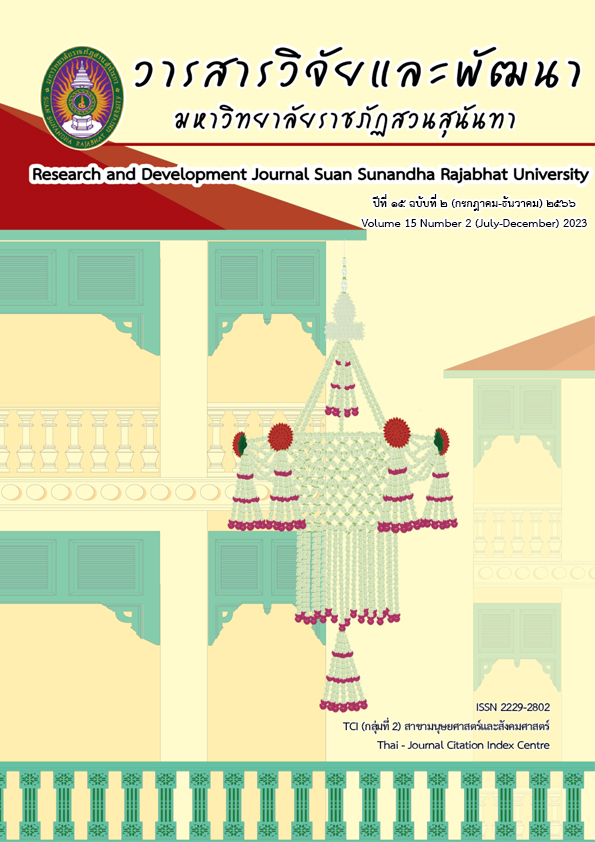สัมพันธภาพระหว่างครูกับเด็กที่ส่งเสริมการคิดอย่างมีวิจารณญาณของเด็กวัย
คำสำคัญ:
สัมพันธภาพระหว่างครูกับเด็ก, การคิดอย่างมีวิจารณญาณ, เด็กวัยอนุบาลบทคัดย่อ
บทความวิชาการนี้มีวัตถุประสงค์เพื่อเสนอสัมพันธภาพระหว่างครูกับเด็กที่ส่งเสริมการคิดอย่างมีวิจารณญาณของเด็กวัยอนุบาล ซึ่งสัมพันธภาพ เป็นความสัมพันธ์ระหว่างบุคคลที่แสดงถึงปฏิสัมพันธ์และความเกี่ยวข้องผ่านท่าทาง การเคลื่อนไหว การสัมผัสโอบกอด และอารมณ์เชิงบวก รอยยิ้ม ความเป็นมิตร หรือสนทนาโต้ตอบ ซึ่งสัมพันธภาพระหว่างครูกับเด็กที่ส่งเสริมการคิดอย่างมีวิจารณญาณของเด็กวัยอนุบาลแบ่งเป็น 3 ลักษณะ ได้แก่ 1) สัมพันธภาพทางอารมณ์ เป็นการแสดงความรู้สึกเชิงบวกของครู เมื่อเด็กทำกิจกรรม เล่น หรือแก้ปัญหาด้วยตนเอง และรอคอยให้เด็กคิดคำตอบหรือลงมือทำ ด้วยใบหน้ายิ้มแย้มและเป็นกันเองกับเด็ก 2) สัมพันธภาพทางวาจา เป็นการแสดงคำพูดของครู การสนทนา และการตั้งคำถามกระตุ้นความสงสัยของเด็กด้วยเสียงที่นุ่มนวล ใช้ภาษาที่เข้าใจง่าย และ 3) สัมพันธภาพทางกาย เป็นการแสดงการกระทำของครู ด้วยสีหน้าและสัมผัสที่อบอุ่น แสดงการตอบสนองทางร่างกายกับเด็ก และใช้สื่อกระตุ้นความสนใจ หรือสร้างบรรยากาศให้เด็กคิด ซึ่งสัมพันธภาพระหว่างครูกับเด็ก ส่งผลต่อความสำเร็จในการเรียนรู้และเพิ่มแรงจูงใจให้เด็กฝึกคิดหลายลักษณะผ่านการตั้งคำถาม สร้างความเข้าใจ คาดคะเน วิเคราะห์ สร้างสรรค์ ประเมิน อธิบาย หรือแก้ปัญหา ซึ่งแนวทางการส่งเสริมการคิดอย่างมีวิจารณญาณ ได้แก่ 1) การใช้คำถามที่ส่งเสริมการคิดกับเด็ก 2) การให้เด็กอภิปราย 3) การให้เด็กปฏิบัติกิจกรรมที่ได้คิดร่วมกัน 4) การใช้สื่อส่งเสริมการคิด และ 5) การมีส่วนร่วมในการคิดของเด็ก อันเป็นพื้นฐานที่ปลูกปั้นให้เด็กเติบโตเป็นบุคคลที่สามารถคิดและเรียนรู้ได้ตลอดชีวิต พร้อมปรับตัวเข้ากับสังคมยุคใหม่อย่างมีคุณภาพ
เอกสารอ้างอิง
Ardiyan, J. (2020). Teachers’ Strategies in Fostering Students Critical Thinking in SMAN 1 Guguak. Education and Humanities Research, 579, 280–284.
Bailin, S., Case, R., Coombs, J., & Daniels, L. (1999). Conceptualizing critical thinking. Journal of Curriculum Studies, 31(1), 285-302.
Bella Shinta, L. G., Febriani, A., & Widiati, U. (2022). Teacher-Student Relationships at a Kindergarten School as Viewed from Classroom Management Principles. Jurnal Obsesi: Jurnal Pendidikan Anak Usia Dini, 6(2), 611-621.
Bright Horizon. (2021). Building YOUR CHILD'S CRITICAL THINKING SKILLS. Retrieved October 18, 2022, from https://www.brighthorizons.com/resources/Article/developing-critical-thinking-skills-in-children
Bureau of Early Childhood Development Policy. (2020). Educational Management Situation Report for early childhood in Thailand. Bangkok: PRIKWARN GRAPHIC CO.,LTD (In Thai).
Hamre, B. K., Pianta, R. C., Downer, J. T., DeCoster, J., Mashburn, A. J., Jones, S. M., & Brackett, M. A. (2013). Teaching through interactions: Testing a developmental framework of teacher effectiveness in over 4000 classrooms. The Elementary School Journal, 113(4), 461–487.
Hatfielda, E. H., Burchinalb, M. R., Pianta, R. C., & Sideris, J. (2016). Thresholds in the association between quality of teacher–child interactions and preschool children’s school readiness skills. Early Childhood Research Quarterly, 36, 561-571.
Heyman, G. D. (2008). Children’s critical thinking when learning from others. Current Directions in Psychological Science, 17(5), 344–347.
Horadol, A. (2020). Fundamentals of early childhood learning and thinking: the instructional document Develop early childhood thinking. Nonthaburi: The Office of the University Press Sukhothai Thammathirat Open University (In Thai).
ICTE Solutions Australia. (2022). Why is Critical Thinking important in Early Childhood Education? Retrieved October 18, 2022, from www.ictesolutions.com.au
Lee, V., & Burkam, D. (2003). Dropping out of high school: The role of school organization and structure. American Educational Research Journal, 40(2), 353-393.
Ministry of Education. (2017). Early Childhood Curriculum B.E. 2560 [A.D. 2017]. Bangkok: AKSORNTHAI PRINTING LTD (In Thai).
Mulvahill, E. (2018). What Is Classroom Management. We Are Teachers. Retrieved October 20, 2022, from www.weareteachers.com/what-is-classroom-management
Nardi, P. M. (2017). Critical Thinking: Tools for Evaluating Research. California:: University of California Press.
Pornkul, C. (2014). Teaching Thinking Process: Theory and Implementation (3rd ed.). Bangkok: Chulalongkorn university press (In Thai).
Reilly, O. C., Devitt, A., & Hayes, N. (2022). Critical thinking in the preschool classroom - A systematic literature review. Thinking Skills and Creativity, 46, 1-20.
Seenuan, T. (2015). A development of an instructional model to develop early childhood critical thinking through reflective teaching and documentation. Journal of Education Naresuan University, 20(1), 61-74 (In Thai).
Sharma, H. L., & Saarsar, P. (2022). INNOVATIVE TEACHING STRATEGIES TO FOSTER CRITICAL THINKING: A-REVIEW. International Journal of Creative Research Thoughts, 10(5), 883-889.
Sinthaphanon, S. (2009). Innovation in teaching and learning to develop the quality of youth (3rd ed.). Bangkok: 9119 TECHNIC PRINTING LTD (In Thai).
Srisuwan, S. (2011). The relationships between teacher-child relationship and prosocial behavior of preschoolers. An Online Journal of Education, 10(1), 498-512 (In Thai).
Strasser, J., & Bresson, L. M. (2017). Big questions for young minds: Extending children’s thinking. Washington: National Association for the Education of Young Children.
Thamborworn, N. (2006). The development of thinking processes in early childhood (5th ed.). Bangkok: Chulalongkorn university press (In Thai).
The Center on the Social and Emotional Foundations for Early Learning. (n.d.). Building Positive Teacher-Child Relationship. Retrieved October 19, 2022, from http://csefel.vanderbilt. edu/briefs/wwb12.html
The Organisation for Economic Co-operation and Development. (2018). The future of education and skills Education 2030. Retrieved October 9, 2022, from https://www. oecd.org/education/2030/E2030%20Position%20Paper%20(05.04.2018).pdf
Thirachit, W. (2013). How to teach enhance life experience (12th ed.). Nonthaburi:: The Office of the University Press Sukhothai Thammathirat Open University (In Thai).
Wadsworth, B. J. (1996). Piaget's Theory of Cognitive and Affective Development (5th ed.). London: Longman.
Yoleri, S. (2016). Teacher-child Relationships in School Period: The Roles of Temperaments and Language Skills. International Journal of Elementary Education, 9(1), 210-224.
ดาวน์โหลด
เผยแพร่แล้ว
รูปแบบการอ้างอิง
ฉบับ
ประเภทบทความ
สัญญาอนุญาต
ลิขสิทธิ์ (c) 2023 มหาวิทยาลัยราชภัฏสวนสุนันทา

อนุญาตภายใต้เงื่อนไข Creative Commons Attribution-NonCommercial-NoDerivatives 4.0 International License.
บทความที่ได้รับการตีพิมพ์เป็นลิขสิทธิ์ของ สถาบันวิจัยและพัฒนา มหาวิทยาลัยราชภัฎสวนสุนันทา
ข้อความที่ปรากฏในบทความแต่ละเรื่องในวารสารวิชาการเล่มนี้เป็นความคิดเห็นส่วนตัวของผู้เขียนแต่ละท่านไม่เกี่ยวข้องกับมหาวิทยาลัยราชภัฎสวนสุนันทา และคณาจารย์ท่านอื่นๆในมหาวิทยาลัยฯ แต่อย่างใด ความรับผิดชอบองค์ประกอบทั้งหมดของบทความแต่ละเรื่องเป็นของผู้เขียนแต่ละท่าน หากมีความผิดพลาดใดๆ ผู้เขียนแต่ละท่านจะรับผิดชอบบทความของตนเองแต่ผู้เดียว





